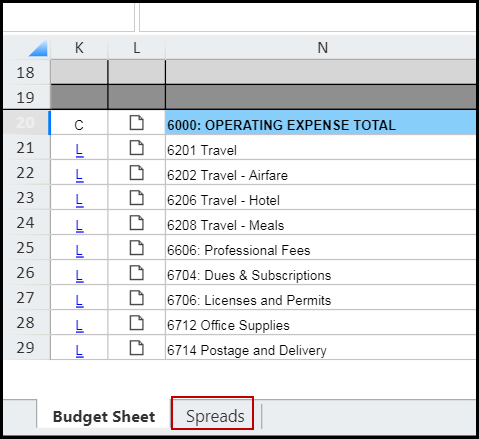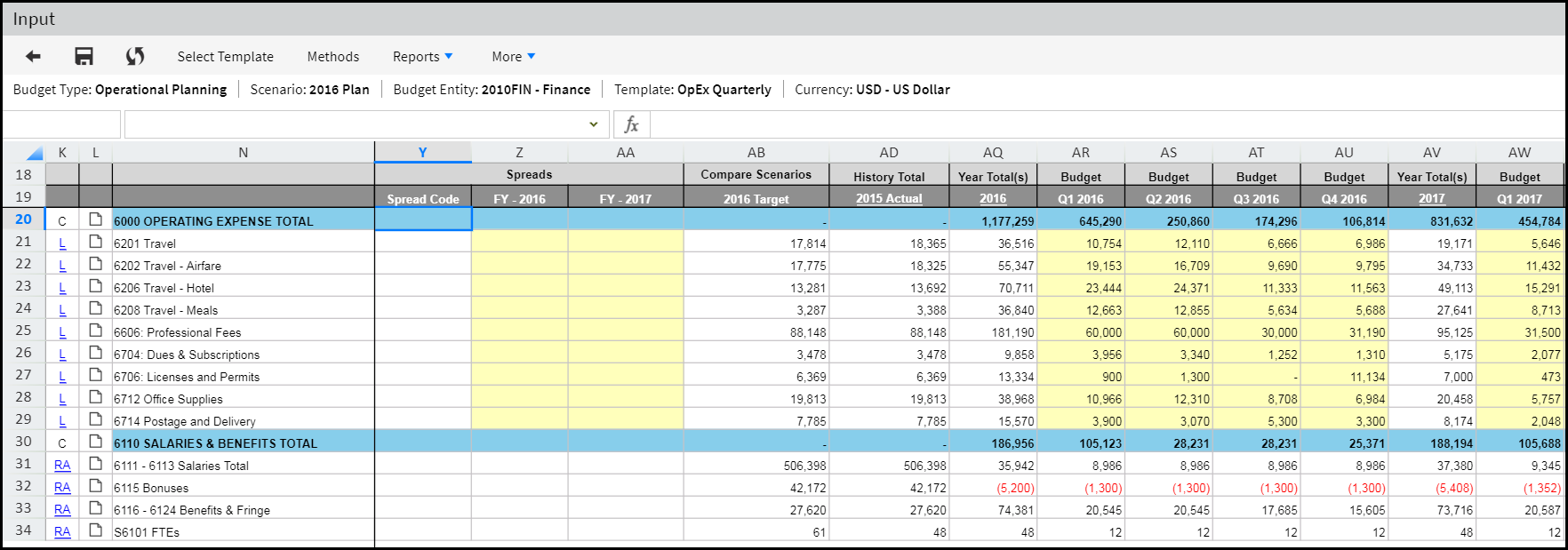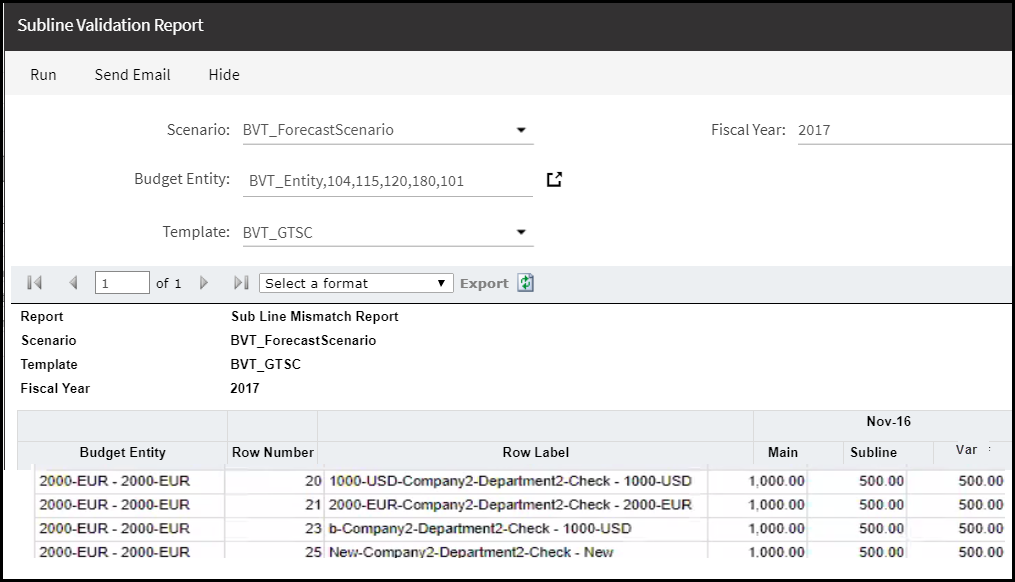- 7 Minutes to read
- Print
- DarkLight
- PDF
Global Templates
- 7 Minutes to read
- Print
- DarkLight
- PDF
What is the Difference Between Global Template Single Copy and Global Template Entity Copy Types
Template input options are similar for both the Global Template Single Copy and Global Template Entity Copy types. The difference between these two template types is that for Global Temple Single Copy, the template will be the same for every entity from where it's opened. For Global Template Entity Copy, the template can be changed from entity to entity
Example of a Global Template Single Copy
The image below shows an example of a Global Template Single Copy template type. Notice the options in the ribbon. You can select Template, Methods, Reports, and the More list box.

Information on the budget type, scenario, budget entity, template that is opened, and the currency the template is in is provided for information purposes under the ribbon. This information cannot be edited.
What is the Methods Selection Pane
The Methods list box opens the Method Selection pane. Selections are made available based on template type and how the template was set up by your Admin. Fields available for the Operating Expenses template are explained below.

Monthly Increase in $ - Apply an increased dollar amount based on historical amounts for each month. Optionally, Round the number to the nearest whole number. For example; 67.7 will appear as 68. Click Apply.
Monthly Increase in % - Apply an increased percent based on historical amounts for each month. Optionally, Round the number to the nearest whole number. For example; 67.7 will appear as 68. Click Apply.
Full Year Growth - Apply a total increase percent based on history and use a spread method to distribute the amounts to the monthly periods. The spread method may be based on history or custom-defined spread methods created for the template. Optionally, Round the number to the nearest whole number. For example; 67.7 will appear as 68. Click Apply.
Annual Value - Apply a total dollar amount based on history and use a spread method to distribute the amounts to the monthly periods. The spread method may be based on history or custom-defined spread methods created for the template. Optionally, Round the number to the nearest whole number. For example; 67.7 will appear as 68. Click Apply.
What is the Purpose of the Spreads Tab at the Bottom of the Template
This Option might be available based on how your Admin user set up the application:
Spread methods are made available by your Admin. Spreads allow you to spread data from a total column to period columns. View spreads by clicking the Spreads tab at the bottom on the screen (shown below).


Spread methods can be applied to a template row. Your administrator makes spread methods available to you for applicable templates. In the example below, quarterly and seasonal spread methods are defined.

The Quarterly spread will spread data evenly over the 4 quarters in years 2016 and 2017. The Seasonal spread will spread more data during quarters 2 and 3. The budget sheet (Input template) is displayed below.

Click the Methods tab and select Annual Value. The spreads are displayed as shown below.

Select a spread (in this case Quarterly ) and click Apply.
The spread code cell is updated for the line to Quarterly.

When you enter data in FY-2016 or FY-2017 and press enter, the data will be reflected in the corresponding periods for that year.
What are Global Fields
Global Fields are made available by your Admin and are used in budget and forecast calculations in templates. Selecting this option applies the global field to a template row. An example of a global field might be a constant surcharge on warehouse items delivered for a manufacturing entity. Or, a sign-on bonus amount for employees.
What are the Options Available Under the More List Box
The More list-box contains many options, which vary based on template type.

Budget Entity Approval - Perform entity approval actions from within the template rather than returning to the Planning Control Panel.
Template Approval - Perform template approval actions from within the template rather than returning to the Planning Control Panel.
Account Reports:
Destination - Destination accounts are used for saving the budget or forecast data entered or calculated in a selected budget template against a General Ledger account. This report displays each line that is identified as a destination account, along with segment mapping information.
Reference - In the image below, the template has RA lines. RA indicates that the line references another account. Select the Reference Account Report to view a report on all accounts referenced in the template.

Show Rule - View a report on all associated rules (MDX formulas/expressions).
Output - Print, email or save the template.
Header
Notes - View all notes associated with the template.
Documents - View all documents associated with the template. Administrators can attach documents.
Snapshot - Take a snapshot of the template data. You can store snapshots in a folder in the File Cabinet.
Template History -View details on who last modified the template, the modification date, and description.
Subline
Subline Validation - This feature checks every main template line against associated sublines and verifies the data matches. If the data does not match, template lines are highlighted in red as shown below.

Validation Report - Run the Subline Validation report to view all Subline discrepancies between sublines and main lines for a template. To access the report, open a template in View or Input mode. Click the More list-box and select Validation Report.
The Subline Validation report is a Standard Report. Admin users can access Standard Reports by navigating to Maintenance > Reports > Standard Reports. Select the Subline Validation Report, click More and select Deploy to make the report available to users. You can run the report from this interface in addition to the Template interface.
When you run the Subline Validation Report, you will be prompted to select a scenario, entity, template and fiscal year. Sample report output is shown below.

Grid Actions
Show/Hide Formula Bar - Display or hide the Excel formula bar.

Show/Hide Row Header - Show or hide the template row numbers.
Show/Hide Column Header - - Hide or display the template column letters.
Show/Hide Tabs - Show or hide the tabs for Global Fields and Spreads that appear at the bottom of the Template Input and View screens.
Show/Hide Scenario Header - Display or hide column header information. Column scenario headers display scenario name. Admin users can choose to set the display globally (to hide or show) for column headers. If an Admin user hides the display of column headers globally, other users will not be able to see this information.
Show/Hide Column - Hide or show selected columns (within any template except Initiative templates) to improve visibility.
Reset Column Width - Reset the column width based on the template setup your Admin user performed.
Show/Hide Data Filter - Filter Spreadsheet Data similar to Excel as shown below. Data filter functionality is available for the following template types: Allocation, Block, Sales, Global Template - Single Copy, Global Template - Entity Copy, Line Item, and HR.

Hide/Show Format Bar - Display or hide the format area, which is where you insert lines, borders, format numbers, and more.
Freeze/UnFreeze Grid - Select Freeze to keep an area of the worksheet visible while you scroll to another area. UnFreeze disables this ability. Freeze panes are user-specific. For example, Jane Doe can set her freeze panes for the BudgetQ12019 template (from the Planning Control Panel - Template Input page) and John Doe can set his freeze panes as desired for the same template. Even if Jane and John have different freeze pane settings, the template will display accordingly based on their selections.
Reset Column Width Globally - Set columns widths to a default width. This option is available for Global Template Single Copy, Global Template Entity Copy, and Allocation template types. Selecting this option will reset column width preferences of all template users for a specific scenario irrespective of the budget entities. This option is available for templates that are not associated with the Default scenario only
Hide/Show Attributes - Display or show the Attributes column.
Display Data
Display Data is available when Expedited Loading is enabled by your Admin. Display Data appears after history, reference, and closed period data have completed loading in the cloud and are ready to populate the template.
With Expedited Loading, you can proceed with budgeting tasks while template data is processed in the cloud and ultimately populated in your template structure.
Data input lines are immediately available for input while reference, history, and closed period data is downloaded in the cloud. You can perform data input for unlocked cells. However, you cannot save the template until the loading process is complete. Once all data is loaded, click Display Data (link on notification message) to load all reference, history, and closed period data.

